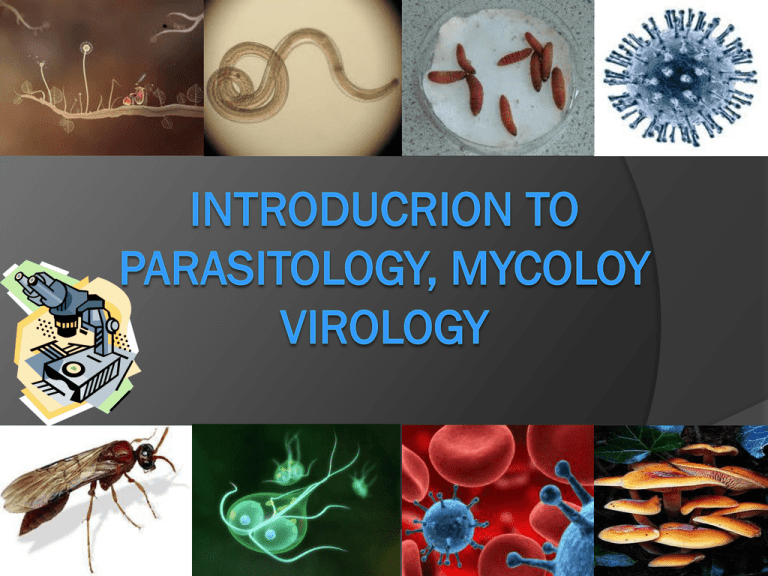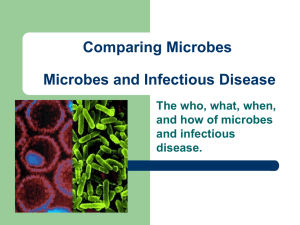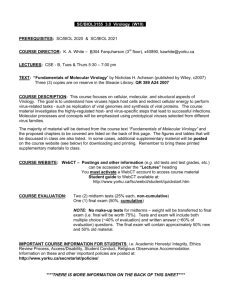المحاضرة رقم 1
advertisement

Introduction to Parasitology Each animal is a host of many parasites; thus, there are far more parasitic organisms on earth than there are nonparasitic organisms. It has been estimated that more than 50% of all living plants and animals are parasitic at some stage during their life cycle. There are 3 major groups of parasites: 1. Protozoa- Protozoans are microscopic onecelled organisms that are categorized according to their method of movements flagellates, amebas, ciliata 2. Helminths - parasitic worms such as the flukes, tapeworms, and roundworms 3. Arthropods - insects and arachnids that are ectoparasites and carriers (vectors) of diseases Protozoa! Helminths! Arthropods! Why do we study parasites? • Parasites provide unique examples of biological phenomena not found in free-living organisms. ○ Medical Importance ○ Veterinary Importance ○ Economic Importance Medical Importance of Parasites • Humans are hosts to many species of parasites. • Many of these parasites are causative agents of major public health problems of the world. Examples of Medical Importance in the World The life expectancy of an Egyptian is in the mid-40's due to Schistosomes. 15 million children in the world will die this year from a combination of malnutrition and parasites. Over 1 million African children will die this year from the effects of malaria. Many cases of plague, transmitted by fleas, still occur throughout the world. Introduction to Mycology Mykes (Greek word) : Mushroom Fungi are eukaryotic protista; differ from bacteria and other prokaryotes. 1. Cell walls containing chitin (rigidity & support) & 2. 3. 4. 5. other polysaccharides Cytoplasmic membrane contains ergosterols Possess true nuclei with nuclear membrane & paired chromosomes. Divide asexually, sexually or by both Unicellular or multicellular Characteristics of Fungus Diverse group of chemo heterotrophs > 90,000 known species Saprophytes: Digest dead organic matter Parasites: Obtain nutrients from tissues of organisms Molds & mushrooms are multicellular Yeasts are unicellular Fungus Everywhere 12 How the fungus are nourished Absorption of nutrients: powerful Exoenzyme Grow at lower pH-5 than bacteria Grow in high salt and sugar Metabolize complex CH2O like lignin in wood-wood rot FUNGI (Mycology) - Over 100,000 fungal species identified. Only about 100 are human or animal pathogens. - Most human fungal infections are nosocomial and/or occur in immunocompromised individuals (opportunistic infections). Yeasts and molds Yeasts and molds have different structural and reproductive characteristics Yeast are unicellular, nucleated rounded fungi while molds are multicellular, filamentous fungi Yeast reproduce by a process called budding while molds produce spores to reproduce Some yeast are opportunistic pathogens in that they cause disease in immuno-compromised individuals Yeast are used in the preparation in the variety of foods Fungal Diseases Mycosis- fungal infection Not highly contagious Humans acquire from nature Groups based on degree on tissue involvement and mode of entry Cutaneous mycoses-dermatophytes Epidermis, hair & nails Contagious-direct or indirect contact Introduction to Virology A virus is an obligate intracellular parasite containing genetic material surrounded by protein Virus particles can only be observed by an electron microscope Introduction to Virology The classification of viruses is based on the type of nucleic acid contained within RNA viruses---also known as a retrovirus DNA viruses Introduction to Virology Recognizing the shape, size, and structure of different viruses is critical to the study of disease Viruses have an inner core of nucleic acid surrounded by protein coat known as an envelope Most viruses range in sizes from 20 – 250 nanometers Introduction to Virology Replication Viruses replicate within a host cell while utilizing the host cell’s nucleic acids. Introduction to Virology Viral life cycle consists of six stages within the host cell Attachment Penetration Uncoating Multiplication Assembly Release Introduction to Virology The cultivation of viruses is complex and includes three common methods Chicken egg culture Cell culture Animal inoculation Introduction to Virology Viral Diseases-Examples Influenza Rabies HIV Hepatitis


